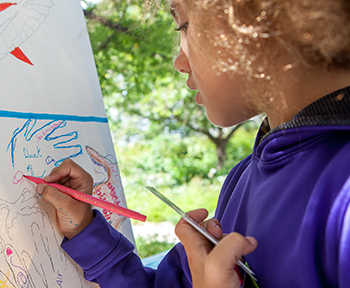
Audubon Adventures
Seabirds: Feathered Ocean Mariners

Activities
 Activity 2
Activity 2
Getting the Message Out: Let’s Help Seabirds!
 Teacher-led Classroom Activity
Teacher-led Classroom Activity
Science/Language Arts/Art
How can young people inform the public about threats to seabirds?
Objective:
Students choose a seabird-related or other conservation message and create art that communicates it.
Students will need:
- Art materials (appropriate to kinds of projects chosen)
- Pencil and paper
Suggested time:
One class period for discussion and planning, another for creating artworks.
 What to do:
What to do:
- Start by having students revisit these features in their issues of the Seabirds magazine: “Seabirds in Trouble” and “Seabird Nesting Colonies” (page 3); “What Can You Do?” and “Saving Seabirds from Fishing Gear” (page 4). Read them as a class and discuss the various challenges and threats to seabirds they describe: climate change, commercial fishing practices, pollution from fossil fuels and trash, habitat loss, disturbance by humans, discarded fishing gear.
- Move the discussion to how people can help—e.g., reduce use of fossil fuels, clean up trash, avoid leaving fishing line and nets in the environment, staying away from nesting seabird colonies. Invite students to suggest what people in their own town or city could do to help protect seabirds and their ocean and shoreline habitats. What messages would students want to communicate to the public? Examples might deal with keeping trash out of waterways, telling the world about the kinds of threats seabirds face, explaining why it’s important to stay clear of nesting seabirds, and so on.
- Divide the class into small groups or pairs of students. Challenge each to choose a message and design and create a work of art that tells people about it. Depending on the art supplies available, you can limit students to posters, sculptures, collages, etc. Students might also write skits, songs, or poems that tell about seabirds.
- Consider displaying their work and performing skits or reading written work in a public place in the school or community.
Extension: Contact your local Audubon chapter to find out if they might want to exhibit or share the story of your students’ art projects.
Photos: (t to b) Jean Hall; CamillaCerea/Audubon




